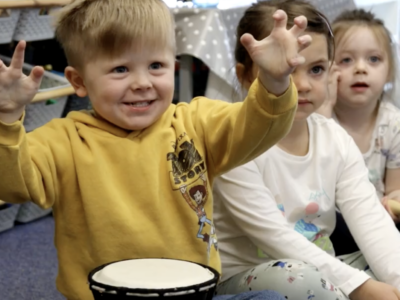 When our youngest learners embark on the journey of learning to read and write, one fundamental skill stands out as a cornerstone: phonological awareness. Often overlooked but profoundly impactful, phonological awareness lays the groundwork for literacy development, unlocking the world of language for children.
When our youngest learners embark on the journey of learning to read and write, one fundamental skill stands out as a cornerstone: phonological awareness. Often overlooked but profoundly impactful, phonological awareness lays the groundwork for literacy development, unlocking the world of language for children.
Phonological awareness encompasses a range of skills related to the ‘sounds’ of language such as rhyming, segmenting words into  syllables, identifying individual sounds within words (phonemic awareness), and manipulating these sounds to create new words or recognise existing ones. Essentially, it is the awareness of the sound structure of language, independent of its written form. This can be at the sentence, word, syllable, and phoneme (separate sound) level. Whilst all levels can affect a person’s reading and writing, it is the phoneme level that is of particular interest, as phonemes are the smallest, most basic elements of language.
syllables, identifying individual sounds within words (phonemic awareness), and manipulating these sounds to create new words or recognise existing ones. Essentially, it is the awareness of the sound structure of language, independent of its written form. This can be at the sentence, word, syllable, and phoneme (separate sound) level. Whilst all levels can affect a person’s reading and writing, it is the phoneme level that is of particular interest, as phonemes are the smallest, most basic elements of language.
Phonemic awareness is an essential skill that underlies learners’ reading and spelling abilities. Sitting under the umbrella of phonological awareness, it is the key to learning to read and forms the foundation upon which other reading skills, such as phonics and fluency, are built.
By developing phonological awareness, children learn to recognise that words are made up of smaller units of sound, known as phonemes. Phonemic awareness is essential for grasping the alphabetic principle — understanding that letters represent sounds and that these sounds combine to form words. This understanding and crucial scaffolding enables them to decode words when reading and encode them when writing.
An early grasp of phonological awareness not only predicts future reading and writing success but also helps identify children who may be at risk for literacy difficulties. Learners with underdeveloped language and communication skills struggle to make the link between letters and sounds. Children as young as 3 or 4 who have difficulties in playing word games that involve rhyming or alliteration may have difficulties with their phonemic awareness and are at risk of dyslexia when they are older. Likewise, children with hearing difficulties (such as glue ear or who have had grommets fitted) or have problems in accurately articulating speech sounds when talking, could also have difficulties in learning to read and to spell.
By assessing and addressing phonological awareness skills in early childhood, educators can intervene proactively to support struggling learners and prevent later literacy problems.
 Fortunately, phonological awareness is a skill that can be developed through targeted instruction and practice. Early childhood educators employ various strategies to nurture phonological awareness in young learners – a key developmental stage before the formal introduction of systematic phonics.
Fortunately, phonological awareness is a skill that can be developed through targeted instruction and practice. Early childhood educators employ various strategies to nurture phonological awareness in young learners – a key developmental stage before the formal introduction of systematic phonics.
Phonemic Awareness Activities: Engaging children in activities that focus on isolating, blending, segmenting, and manipulating individual sounds within words.
Rhyming Games: Encouraging children to recognise and generate rhymes fosters an understanding of word endings and sound patterns.
Syllable Segmentation: Breaking words into syllables helps children recognise the rhythmic structure of language and improves their ability to decode unfamiliar words.
Phonological Awareness Games and Songs: Incorporating playful activities, songs, and games that emphasise sound awareness makes learning enjoyable and memorable.
 By targeting and developing both phonological and phonemic awareness through high quality speaking and listening activities, children learn to become attuned to the sounds of spoken language and begin to develop oral blending and segmenting skills. This teaching lays the foundations for systematic synthetic phonics and equips young learners with essential literacy skills that pave the way for academic achievement and lifelong learning.
By targeting and developing both phonological and phonemic awareness through high quality speaking and listening activities, children learn to become attuned to the sounds of spoken language and begin to develop oral blending and segmenting skills. This teaching lays the foundations for systematic synthetic phonics and equips young learners with essential literacy skills that pave the way for academic achievement and lifelong learning.
Recognising the vital role of phonological awareness in early education is not just about teaching children to read and write—it’s about unlocking the door to the power of language.